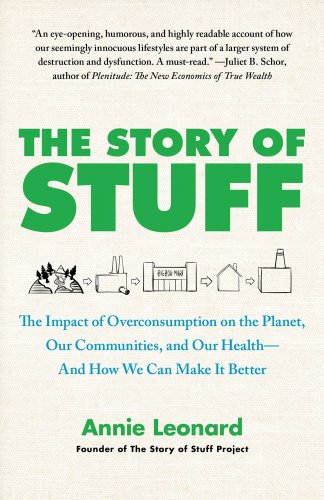Tuesday, February 22, 2011
The Story of Stuff by Annie Leonard
Description:
Americans have way too much Stuff , and way too much of it is toxic. That's the message Annie Leonard has been spreading ever since her college days, and most recently in her short Internet film The Story of Stuff, which has been viewed by over 12 million people. But the film is only the tip of the iceberg.
This astonishing, inspiring book takes her message to an even higher level. In it she outlines the perils of overconsumption as she traces products back to their sources, through their life spans, and forward into their disposal. The Story of Stuff works on all levels as it brings together information on the environment, the economy, and cultures around the world.
With her trademark compassion, curiosity, and playfulness, Leonard gives firsthand accounts of sneaking into dumps and factories around the world; chronicles the lives of Haitian textile workers and Congolese kids working in deadly mines; shows how our health and well-being are compromised by neurotoxins in our pillows and lead in our children's lunch boxes; and most important, tells us that this is not the way things have to be. She presents concrete steps for taking action that point the way toward saving our health, our communities, and the planet.
From high school kids to their parents in the suburbs, from government officials to people working in corporations, schools, and churches, The Story of Stuff is a life-changing book. Like Rachel Carson's Silent Spring, it will transform the way you think and act.
My take on this book:
"The Story Of Stuff" is a thought provoking book, but also a bit depressing if you really think about it. Before picking up this book I thought I was doing my part to keep the planet green, I use freecycle regularly to get rid of my unwanted stuff, I also donate to Goodwill, and try to recycle as much as I can, but heck I learned that many of the things that I recycle have toxic material in them, so instead of recycling more I need to try and waste less.
The author does a great job of showing us the true value of our stuff, where it comes from, and what we do with it when we don't want it anymore, I was really surprised at the amount of garbage the average American produces a day, 4.6 pounds per person, while in China that number is only .70 per person. How can we change that, the author shares some easy ideas especially in the Appendix 2, which we can easily incorporate into our daily lives.
I really was middle of the road with this book, while the author has some good ideas, some are very unrealistic, for example her view on e-books, she instead prefers local bookstores that she can walk or ride her bike to, or to use the public library, because she thinks like all other gadgets the e-reader will be updated every few years. I would think we are saving many many trees with the use of e-readers and now most libraries have e-books to lend, and for someone that lives 25 miles from nowhere, well, its a long pedal to the bookstore. So while there is plenty of fuel for thought in this book my approach is to continue doing what I am doing to keep the planet green, even if it doesn't really make any difference at all.
I was provided a complimentary copy of this book by the publisher in exchange for an honest review.
Subscribe to:
Post Comments (Atom)

No comments:
Post a Comment
Your wonderful comments make my day, thanks for dropping by!